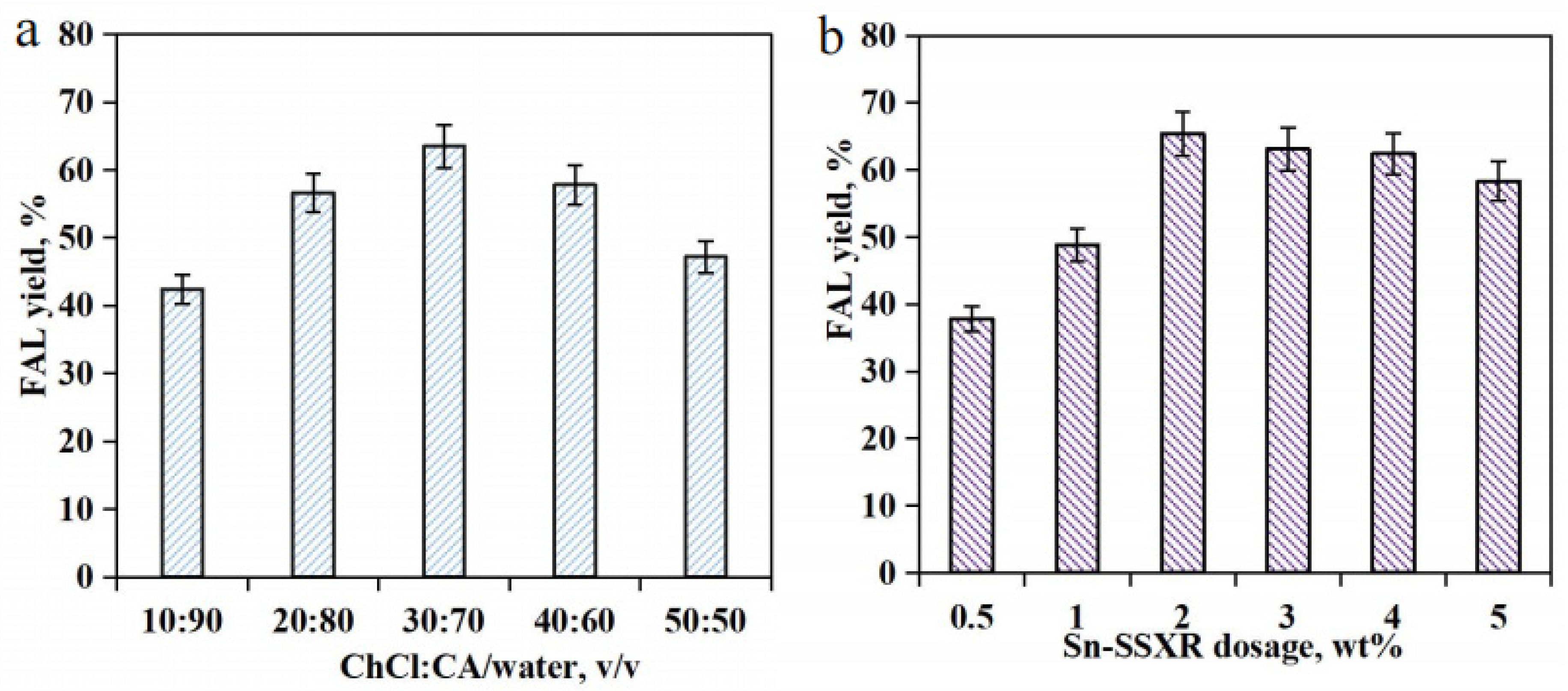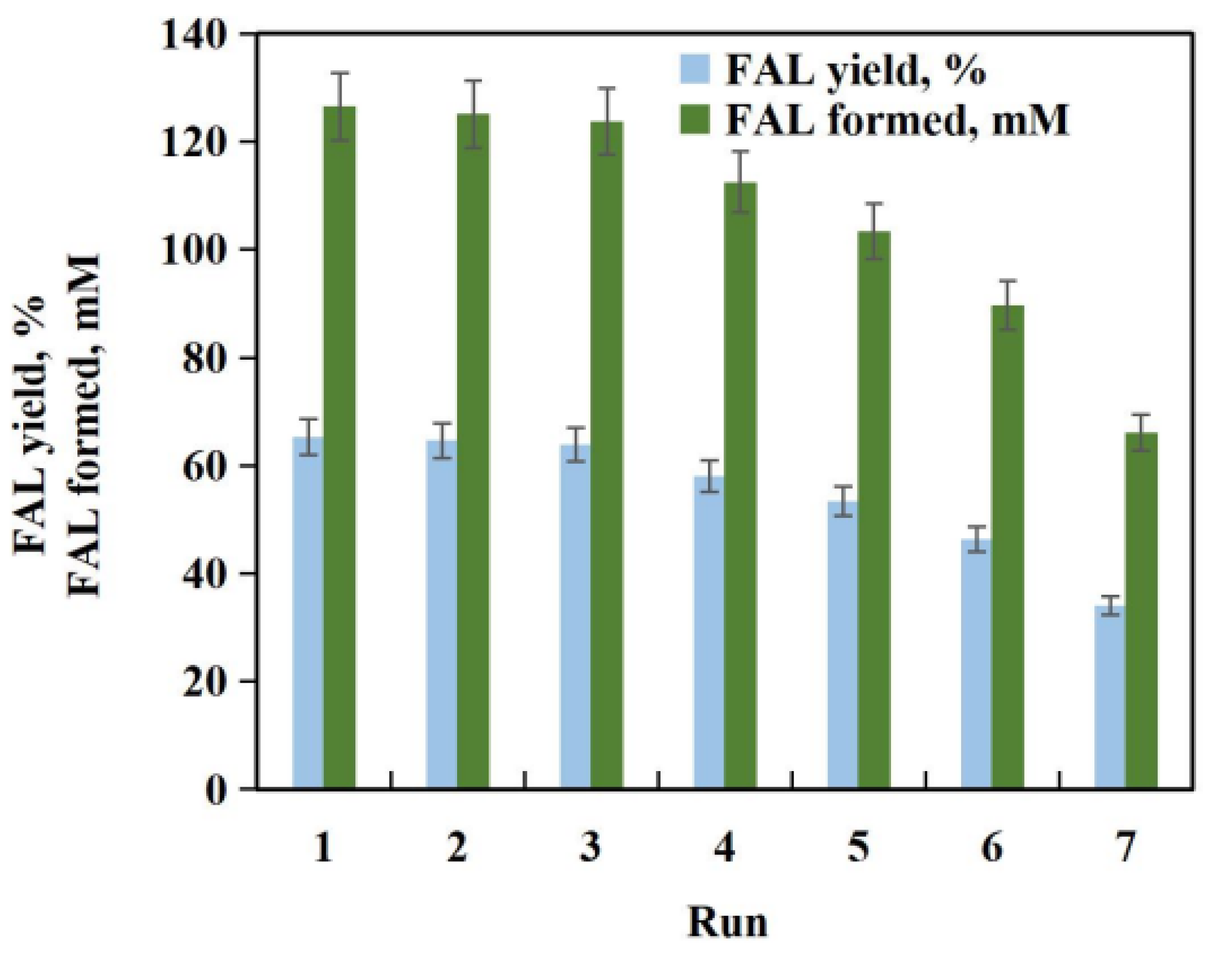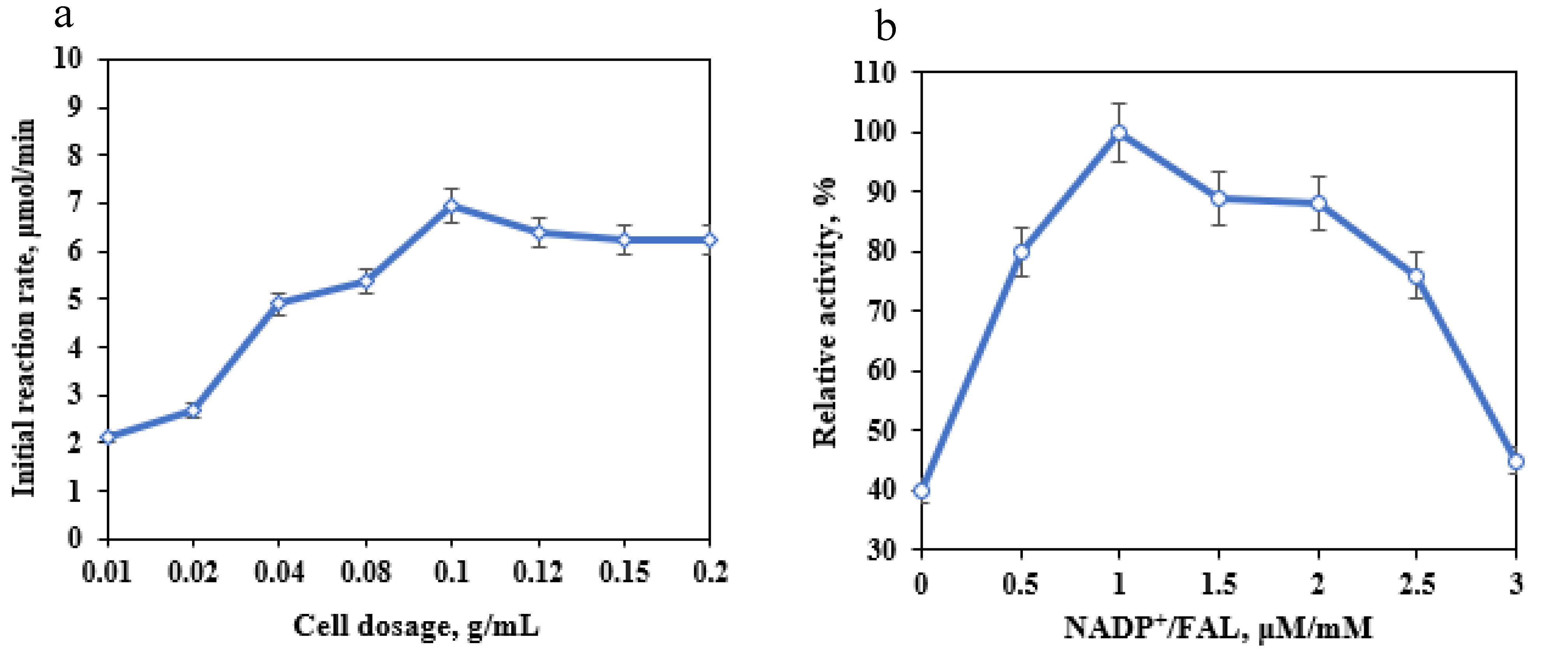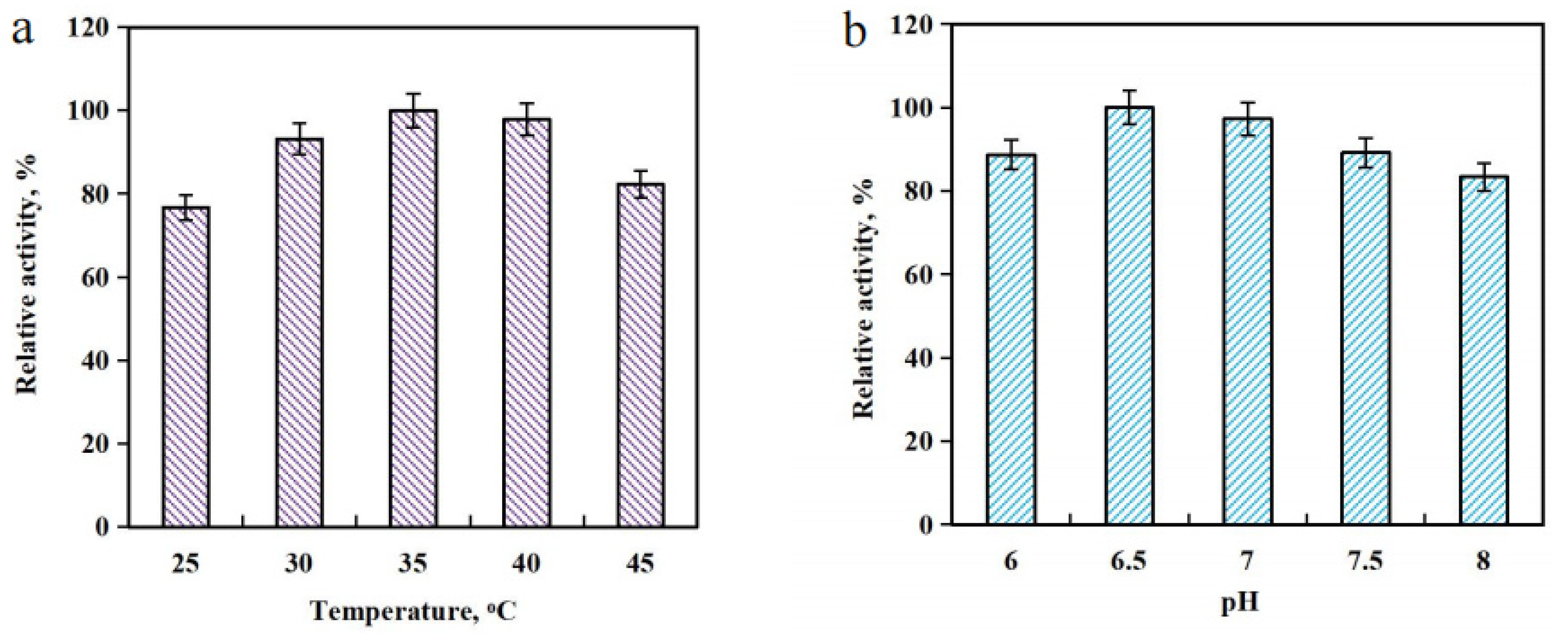Efficient Synthesis of Furfuryl Alcohol from Corncob in a Deep Eutectic Solvent System
Abstract
:1. Introduction
2. Materials and Methods
2.1. Materials and Reagents
2.2. Synthesis of FAL from Biomass
2.3. Whole-Cell Bioreduction of FAL into FOL
2.4. Analytical Method
3. Results and Discussion
3.1. Synthesis of FAL from Corncob in ChCl:LA–Water
| DES | Reaction Conditions | Feedstock | FAL Concentration | FAL Yield | Ref. |
|---|---|---|---|---|---|
| SO42−/SnO2-diatomite (3.6 wt%) | γ-Valerolactone–water (6:4, v/v), 15 g/L ZnCl2, 170 °C, 30 min | Corncob (75 g/L) | - | 68.9% | [16] |
| SO42−/SnO2-kaoline (3.5 wt%) | Toluene–water (1:2 v/v), 10 mM OP-10, 170 °C, 30 min | Corncob-derived xylose (20.1 g/L) | 50.5 mM | 74.3% | [4] |
| SO42−/SnO2-argil (3.6 wt%) | Water, 180 °C, 20 min | Xylose (20 g/L) | 107.6 mM | 57.1% | [9] |
| Sn-ZRD (3.6 wt%) | Water, 170 °C, 30 min | Dewaxed corncob (75 g/L) | 90.3 mM | - | [34] |
| SO42−/SnO2-CS (1.2 wt%) | ChCl:EG–water (5:95, v/v), 185 °C, 20 min | Xylose (75 g/L) | 200 mM | 35.7% | [39] |
| Sn-SSXR (2.0 wt%) | ChCl:LA–water (30:70, v/v), 180 °C, 15 min | Corncob (75 g/L) | 126.3 mM | 65.4% | This study |
3.2. Synthesis of FOL from Biomass-Derived FAL via Bioreduction in ChCl:LA–Water
3.3. Transformation of Corncob to FOL via Chemoenzymatic Approach in ChCl:LA–Water
4. Conclusions
Author Contributions
Funding
Institutional Review Board Statement
Informed Consent Statement
Data Availability Statement
Acknowledgments
Conflicts of Interest
References
- Sudarsanam, P.; Peeters, E.-V.; Makshina, E.; Parvulescu, V.-I.; Sels, B.-F. Advances in porous and nanoscale catalysts for viable biomass conversion. Chem. Soc. Rev. 2019, 48, 2366–2421. [Google Scholar] [CrossRef] [PubMed]
- Wang, K.; Liu, Z.; Chen, B.; Wang, M.; Zhang, Y.; Bi, H.; Zhou, Y.; Huo, Y.; Tan, T. Microbial utilization of carbon dioxide to synthesize fuels and chemicals—Third-generation biorefineries. Synth. Biol. J. 2020, 1, 60–70. [Google Scholar]
- Zhang, J.; Wu, D. Aqueous phase catalytic hydrogenation of furfural to furfuryl alcohol over in-situ synthesized Cu–Zn/SiO2 catalysts. Mater. Chem. Phys. 2021, 260, 124152. [Google Scholar] [CrossRef]
- He, Y.; Jiang, C.; Chong, G.; Di, J.; Wu, Y.; Wang, B.; Xue, X.; Ma, C. Chemical-enzymatic conversion of corncob-derived xylose to furfuralcohol by the tandem catalysis with SO42−/SnO2-kaoline and E. coli CCZU-T15 cells in toluene–water media. Bioresour. Technol. 2017, 245, 841–849. [Google Scholar] [CrossRef]
- Mandalika, A.; Qin, L.; Sato, K.T.; Runge, T. Integrated biorefinery model based on production of furans using open-ended high yield processes. Green Chem. 2014, 16, 2480–2489. [Google Scholar] [CrossRef]
- Salnikova, K.; Matveeva, V.; Bykov, A.; Demidenko, G.; Shkileva, I.; Sulman, E. The liquid phase catalytic hydrogenation of the furfural to furfuryl alcohol. Chem. Eng. Trans. 2018, 70, 379–384. [Google Scholar] [CrossRef]
- Gomez Millan, G.; Sixta, H. Towards the green synthesis of furfuryl alcohol in a one-pot system from xylose: A review. Catalysts 2020, 10, 1101. [Google Scholar] [CrossRef]
- Tolek, W.; Khruechao, K.; Pongthawornsakun, B.; Mekasuwandumrong, O.; Aires, F.J.C.S.; Weerachawanasak, P.; Panpranot, J. Flame spray-synthesized Pt-Co/TiO2 catalysts for the selective hydrogenation of furfural to furfuryl alcohol. Catal. Commun. 2021, 149, 106246. [Google Scholar] [CrossRef]
- Xue, X.-X.; Ma, C.-L.; Di, J.-H.; Huo, X.-Y.; He, Y.-C. One-pot chemo-enzymatic conversion of D-xylose to furfuralcohol by sequential dehydration with oxalic acid plus tin-based solid acid and bioreduction with whole-cells. Bioresour. Technol. 2018, 268, 292–299. [Google Scholar] [CrossRef]
- Pan, L.; Li, Q.; Tao, Y.; Ma, C.; Chai, H.; Ai, Y.; He, Y.-C. An efficient chemoenzymatic strategy for valorisation of corncob to furfuryl alcohol in CA:Betaine-water. Ind. Crops Prod. 2022, 186, 115203. [Google Scholar] [CrossRef]
- Kratzer, R.; Woodley, J.-W.; Nidetzky, B. Rules for biocatalyst and reaction engineering to implement effective, NAD(P)H-dependent, whole cell bioreductions. Biotechnol. Adv. 2015, 33, 1641–1652. [Google Scholar] [CrossRef] [Green Version]
- Miyaji, A.; Amao, Y. How does methylviologen cation radical supply two electrons to the formate dehydrogenase in the catalytic reduction process of CO2 to formate? Phys. Chem. Chem. Phys. 2020, 22, 18595–18605. [Google Scholar] [CrossRef]
- He, Y.-C.; Liu, F.; Di, J.-H.; Ding, Y.; Zhu, Z.-Z.; Wu, Y.-Q.; Chen, L.; Wang, C.; Xue, Y.-F.; Chong, G.-G. Effective enzymatic saccharification of dilute NaOH extraction of chestnut shell pretreated by acidified aqueous ethylene glycol media. Ind. Crops Prod. 2016, 81, 129–138. [Google Scholar] [CrossRef]
- Mariscal, R.; Maireles-Torres, P.; Ojeda, M.; Sadaba, I.; Granados, M. Furfural: A renewable and versatile platform molecule for the synthesis of chemicals and fuels. Energy Environ. Sci. 2016, 9, 1144–1189. [Google Scholar] [CrossRef]
- Danon, B.; Marcotullio, G.; de Jong, W. Mechanistic and kinetic aspects of pentose dehydration towards furfural in aqueous media employing homogeneous catalysis. Green Chem. 2014, 16, 39–54. [Google Scholar] [CrossRef]
- Jiang, C.-X.; Di, J.-H.; Su, C.; Yang, S.-Y.; Ma, C.-L.; He, Y.-C. One-pot co-catalysis of corncob with dilute hydrochloric acid and tin-based solid acid for the enhancement of furfural production. Bioresour. Technol. 2018, 268, 315–322. [Google Scholar] [CrossRef]
- Garcia-Sancho, C.; Sadaba, I.; Moreno-Tost, R.; Merida-Robles, J.; Santamaria-Gonzalez, J.; Lopez-Granados, M.; Maireles-Torres, P. Dehydration of xylose to furfural over MCM-41-supported niobium-oxide catalysts. ChemSusChem 2013, 6, 635–642. [Google Scholar] [CrossRef]
- Gong, L.; Xu, Z.-Y.; Dong, J.-J.; Li, H.; Han, R.-Z.; Xu, G.-C.; Ni, Y. Composite coal fly ash solid acid catalyst in synergy with chloride for biphasic preparation of furfural from corn stover hydrolysate. Bioresour. Technol. 2019, 293, 122065. [Google Scholar] [CrossRef]
- Cao, J.; Wu, R.; Zhu, F.; Dong, Q.; Su, E. How to improve the efficiency of biocatalysis in non-aqueous pure deep eutectic solvents: A case study on the lipase-catalyzed transesterification reaction. Biochem. Eng. J. 2022, 179, 108336. [Google Scholar] [CrossRef]
- Martins, M.-A.-R.; Pinho, S.-P.; Coutinho, J.-A.-P. Insights into the nature of eutectic and deep eutectic mixtures. J. Solut. Chem. 2019, 48, 962–982. [Google Scholar] [CrossRef]
- Nolan, M.-D.; Mezzetta, A.; Guazzelli, L.; Scanlan, E.-M. Radical-mediated thiol–ene ‘click’ reactions in deep eutectic solvents for bioconjugation. Green Chem. 2022, 24, 1456–1462. [Google Scholar] [CrossRef]
- Capriati, V.; García-Álvarez, J. Copper-catalyzed Goldberg-type C–N coupling in deep eutectic solvents (DESs) and water under aerobic conditions. Org. Biomol. Chem. 2021, 19, 1773–1779. [Google Scholar]
- Panić, M.; Cvjetko Bubalo, M.; Radojčić Redovniković, I. Designing a biocatalytic process involving deep eutectic solvents. J. Chem. Technol. Biotech. 2021, 96, 14–30. [Google Scholar] [CrossRef]
- Husanu, E.; Mero, A.; Rivera, J.-G.; Mezzetta, A.; Ruiz, J.-C.; D’Andrea, F.; Pomelli, C.-S.; Guazzelli, L. Exploiting Deep Eutectic Solvents and Ionic Liquids for the Valorization of Chestnut Shell Waste. ACS Sustain. Chem. Eng. 2020, 8, 18386–18399. [Google Scholar] [CrossRef]
- Li, W.-X.; Xiao, W.-Z.; Yang, Y.-Q.; Wang, Q.; Chen, X.; Xiao, L.-P.; Sun, C.-R. Insights into bamboo delignification with acidic deep eutectic solvents pretreatment for enhanced lignin fractionation and valorization. Ind. Crops Prod. 2021, 170, 113692. [Google Scholar] [CrossRef]
- Wu, M.; Gong, L.; Ma, C.; He, Y.-C. Enhanced enzymatic saccharification of sorghum straw by effective delignification via combined pretreatment with alkali extraction and deep eutectic solvent soaking. Bioresour. Technol. 2021, 340, 125695. [Google Scholar] [CrossRef]
- Arnaboldi, S.; Mezzetta, A.; Grecchi, S.; Longhi, M.; Emanuelea, E.; Rizzoc, S.; Arduini, F.; Micheli, L.; Guazzelli, L.; Mussini, P.R. Natural-based chiral task-specific deep eutectic solvents: A novel, effective tool for enantiodiscrimination in electroanalysis. Electrochim. Acta 2021, 380, 138189. [Google Scholar] [CrossRef]
- López-Sala, N.; Vicent-Luna, J.-M.; Imberti, S.; Posada, E.; Roldán, M.J.; Anta, J.-A.; Salvador, R.-G.; Balestra, S.-R.-G.; Madero Castro, R.-M.; Calero, S.; et al. Looking at the “water-in-deep-eutectic-solvent” system: A dilution range for high performance eutectics. ACS Sustain. Chem. Eng. 2019, 7, 17565–17573. [Google Scholar] [CrossRef]
- Hammond, O.-S.; Bowron, D.-T.; Edler, K.-J. The effect of water upon deep eutectic solvent nanostructure: An unusual transition from ionic mixture to aqueous solution. Angew. Chem. Int. Ed. 2017, 56, 9782–9785. [Google Scholar] [CrossRef]
- Gong, L.; Zha, J.; Pan, L.; Ma, C.; He, Y.-C. Highly efficient conversion of sunflower stalk-hydrolysate to furfural by sunflower stalk residue-derived carbonaceous solid acid in deep eutectic solvent/organic solvent system. Bioresour. Technol. 2021, 351, 126945. [Google Scholar] [CrossRef]
- Li, Q.; Ren, J.-Q.; Li, Q.; Di, J.-H.; Ma, C.-L.; He, Y. Sustainable conversion of biomass-derived D-xylose to furfuryl alcohol in a deep eutectic solvent-water system. ACS Sustain. Chem. Eng. 2021, 9, 10299–10308. [Google Scholar] [CrossRef]
- Morais, E.-S.; Lopes, A.-M.-D.-C.; Freire, M.-G.; Freire, C.-S.-R.; Silvestre, A.-J.-D. Unveiling modifications of biomass polysaccharides during thermal treatment in cholinium chloride:lactic acid deep eutectic solvent. ChemSusChem 2021, 21, 686–698. [Google Scholar] [CrossRef] [PubMed]
- Lee, C.; Wu, T. A review on solvent systems for furfural production from lignocellulosic biomass. Renew. Sust. Energy Rev. 2021, 137, 110172. [Google Scholar] [CrossRef]
- Zhang, P.; Liao, X.; Ma, C.; Li, Q.; Li, A.; He, Y. Chemoenzymatic conversion of corncob to furfurylamine via tandem catalysis with tin-based solid acid and transaminase biocatalyst. ACS Sustain. Chem. Eng. 2018, 7, 17636–17642. [Google Scholar] [CrossRef]
- Bu, C.; Yan, Y.; Zou, L.; Ouyang, S.; Zheng, Z.; Ouyang, J. Comprehensive utilization of corncob for furfuryl alcohol production by chemo-enzymatic sequential catalysis in a biphasic system. Bioresour. Technol. 2021, 319, 124156. [Google Scholar] [CrossRef]
- Bai, X.; Li, J.; Jia, C.; Shao, J.; Yang, Q.; Chen, Y.; Yang, H.; Wang, X.; Chen, H. Preparation of furfural by catalytic pyrolysis of cellulose based on nano Na/Fe-solid acid. Fuel 2019, 258, 116089. [Google Scholar] [CrossRef]
- Pińkowska, H.; Wolak, P.; Złocińska, A. Hydrothermal decomposition of xylan as a model substance for plant biomass waste—Hydrothermolysis in subcritical water. Biomass Bioenerg. 2011, 35, 3502–3912. [Google Scholar] [CrossRef]
- Chen, Z.; Reznicek, W.; Wan, C. Deep eutectic solvent pretreatment enabling full utilization of switchgrass. Bioresour. Technol. 2018, 263, 40–48. [Google Scholar] [CrossRef]
- Liang, J.; Ji, L.; He, J.; Tang, S.; He, Y. Chemoenzymatic conversion of biomass-derived D-xylose to furfuryl alcohol with corn stalk-based solid acid catalyst and reductase biocatalyst in a deep eutectic solvent-water system. Processes 2022, 10, 113. [Google Scholar] [CrossRef]
- Jiang, H.; Chen, Q.; Pan, J.; Zheng, G.; Xu, J. Rational engineering of formate dehydrogenase substrate/cofactor affinity for better performance in NADPH regeneration. Appl. Biochem. Biotechnol. 2020, 192, 530–543. [Google Scholar] [CrossRef]
- Tee, K.; Xu, J.; Wong, T. Protein engineering for bioreduction of carboxylic acids. J. Biotechnol. 2019, 303, 53–64. [Google Scholar] [CrossRef]
- Li, Y.-Y.; Li, Q.; Zhang, P.-Q.; Ma, C.-L.; Xu, J.-H.; He, Y.-C. Catalytic conversion of corncob to furfuryl alcohol in tandem reaction with in-loaded sulfonated zeolite and NADPH-dependent reductase biocatalyst. Bioresour. Technol. 2021, 320, 124267. [Google Scholar] [CrossRef]
- Bu, C.; Yan, Y.; Zou, L.; Zheng, Z.; Ouyang, J. One-pot biosynthesis of furfuryl alcohol and lactic acid via a glucose coupled biphasic system using single Bacillus coagulans NL01. Bioresour. Technol. 2020, 313, 123705. [Google Scholar] [CrossRef]
- Panagiotopoulou, P.; Vlachos, D.-G. Liquid phase catalytic transfer hydrogenation of furfural over a Ru/C catalyst. Appl. Catal. A-Gen. 2014, 480, 17–24. [Google Scholar] [CrossRef]
- Jiménez-Gómez, C.P.; Cecilia, J.-A.; Durán-Martín, D.; Moreno-Tost, R.-P.; Santamaría-González, G.; Mérida-Roblesa, J.; Mariscal, R.; Maireles-Torres, P. Gas-phase hydrogenation of furfural to furfuryl alcohol over Cu/ZnO catalysts. J. Catal. 2016, 336, 107–115. [Google Scholar] [CrossRef]
- Xu, J.; Zhou, S.; Zhao, Y.; Xia, J.; Liu, X.; Xu, J.; He, B.; Wu, B.; Zhang, J. Asymmetric whole-cell bioreduction of sterically bulky 2-benzoylpyridine derivatives in aqueous hydrophilic ionic liquid media. Chem. Eng. J. 2017, 316, 919–927. [Google Scholar] [CrossRef]
- Liu, Z.-Q.; Dong, S.-C.; Yin, H.-H.; Xue, Y.-P.; Tang, X.-L.; Zhang, X.-J.; He, J.-Y.; Zheng, Y.-G. Enzymatic synthesis of an ezetimibe intermediate using carbonyl reductase coupled with glucose dehydrogenase in an aqueous-organic solvent system. Bioresour. Technol. 2017, 229, 26–32. [Google Scholar] [CrossRef]
- Delbecq, F.; Wang, Y.; Len, C. Conversion of xylose, xylan and rice husk into furfural via betaine and formic acid mixture as novel homogeneous catalyst in biphasic system by microwave-assisted dehydration. J. Mol. Catal. A Chem. 2016, 423, 520–525. [Google Scholar] [CrossRef]
- Chen, X.; Li, H.; Sun, S.; Cao, X.; Sun, R. Co-production of oligosaccharides and fermentable sugar from wheat straw by hydrothermal pretreatment combined with alkaline ethanol extraction. Ind. Crops Prod. 2018, 111, 78–85. [Google Scholar] [CrossRef]
- Besson, M.; Gallezot, P.; Pinel, C. Conversion of Biomass into Chemicals over Metal Catalysts. Chem. Rev. 2014, 114, 1827–1870. [Google Scholar] [CrossRef]
- Jia, H.Y.; Zong, M.H.; Zheng, G.-W.; Li, N. One-pot enzyme cascade for controlled synthesis of furancarboxylic acids from 5-hydroxymethylfurfural by H2O2 internal recycling. ChemSusChem 2019, 12, 4764–4768. [Google Scholar] [CrossRef] [PubMed]
- Ali, N.; Zhang, Q.; Liu, Z.-Y.; Li, F.-L.; Lu, M.; Fang, X.-C. Emerging technologies for the pretreatment of lignocellulosic materials for bio-based products. Appl. Microbiol. Biotechnol. 2020, 104, 455–473. [Google Scholar] [CrossRef] [PubMed]
- Yang, T.-X.; Zhao, L.-Q.; Wang, J.; Song, G.-L.; Liu, H.-M.; Cheng, H.; Yang, Z. Improving whole-cell biocatalysis by addition of deep eutectic solvents and natural deep eutectic solvents. ACS Sustain. Chem. Eng. 2017, 5, 5713–5722. [Google Scholar] [CrossRef]
- Zhou, X.; Huang, T.; Liu, J.; Gao, H.; Bian, H.; Wang, R.; Huang, C.; Sha, J.; Dai, H. Recyclable deep eutectic solvent coupling sodium hydroxide post-treatment for boosting woody/herbaceous biomass conversion at mild condition. Bioresour. Technol. 2021, 320, 124327. [Google Scholar] [CrossRef] [PubMed]








| Biomass | Xylan Content, wt% | FAL, mM (Yield, %) a | FOL Productivity, g FOL/g Xylan b |
|---|---|---|---|
| Corncob | 34.0 | 126.3 (65.4) | 0.66 |
| Sugarcane bagasse | 29.6 | 101.4 (60.3) | 0.61 |
| Rice straw | 29.0 | 95.9 (58.2) | 0.59 |
Publisher’s Note: MDPI stays neutral with regard to jurisdictional claims in published maps and institutional affiliations. |
© 2022 by the authors. Licensee MDPI, Basel, Switzerland. This article is an open access article distributed under the terms and conditions of the Creative Commons Attribution (CC BY) license (https://creativecommons.org/licenses/by/4.0/).
Share and Cite
Qin, L.; Di, J.; He, Y. Efficient Synthesis of Furfuryl Alcohol from Corncob in a Deep Eutectic Solvent System. Processes 2022, 10, 1873. https://doi.org/10.3390/pr10091873
Qin L, Di J, He Y. Efficient Synthesis of Furfuryl Alcohol from Corncob in a Deep Eutectic Solvent System. Processes. 2022; 10(9):1873. https://doi.org/10.3390/pr10091873
Chicago/Turabian StyleQin, Lizhen, Junhua Di, and Yucai He. 2022. "Efficient Synthesis of Furfuryl Alcohol from Corncob in a Deep Eutectic Solvent System" Processes 10, no. 9: 1873. https://doi.org/10.3390/pr10091873





